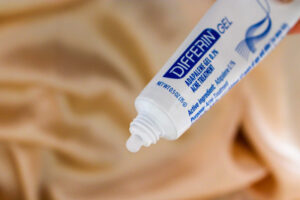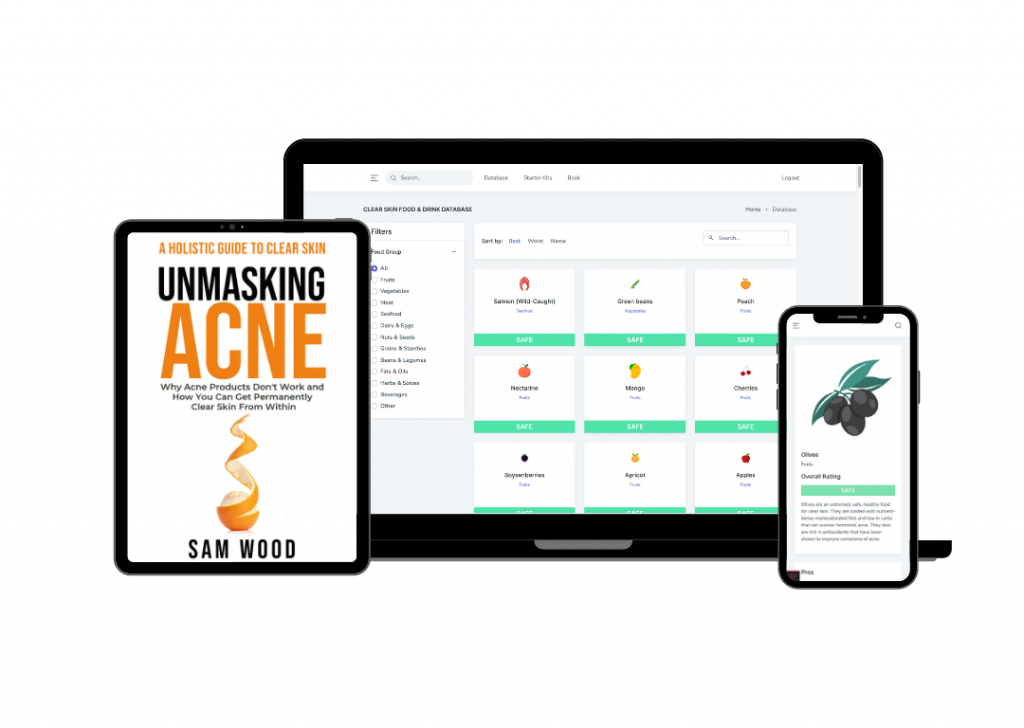Purging is a pesky problem faced regularly by acne sufferers. It can be provoked by anything from a new skincare product to a new anti-acne medication, but it always feels like a massive setback when it happens.
But does differin cause purging? This new anti-acne gel has been making headlines for being one of the first over-the-counter topical retinoids suitable for treating acne. But is using differin gel going to break you out for a few weeks (or months!) before working its magic? Let’s take a look.
First Of All, What Is Purging?
If you’re familiar with the term, purging describes a phase in which a new skincare product causes your skin to break out. Purging is typically caused by a product that clears out the skin, as the product empties the pores and brings any clogged oil, sebum, or bacteria to the skin’s surface. This can cause spots and pimples and might give you the impression that your new skincare product is a dud.
However, purging isn’t actually a bad thing. Lots of anti-acne skincare products often warn users that regular use can trigger a purging phase, which can usually last from one to two weeks.
Lots of different skincare products can cause purging, but it’s mostly known to occur with retinols, acids and exfoliants. Some of the following ingredients are known to trigger purging breakouts when used for the first time:
- Retinols
- Alpha and beta hydroxy acids,
- Salicylic acid
- Benzoyl peroxide
It’s important to note that the purging phase for most skincare products is temporary and we should actually see it as a positive thing – it means the product is working. Do also note that there’s nothing wrong with you if you don’t purge – all skin types are different and everybody reacts to skin care products in a different way.
Put simply, purging can mean that your new product is clearing up your skin, allowing you to make way for a blemish-free complexion once the breakouts clear up. So with all that in mind, does Differin cause purging?
What Is Differin?
Differin is a topical gel used to treat acne and inflammation on the surface of the skin. Differin refers to the brand name of the gel, but the most important ingredient in this product is adapalene. Adapalene is a retinoid (aka a derivative of vitamin A) that has been used in anti-acne treatments for decades.
Belonging to the retinoid family, adapalene helps regulate skin cell regeneration. Skin cell regeneration is what helps heal acne wounds and clear up pimples fast. It can also speed up the new-pimple-process, as the skin pushes out wanted bacteria and sebum rapidly from the skin.
We talk a lot about the benefits of retinol at GoodGlow, but it does seem to be a powerful ingredient with proven results in helping improve the appearance (and development) of acne.
Other topical retinoids exist to treat acne – most commonly tretinoin and tazarotene – but what makes Differin so popular is that you can get hold of it over-the-counter. Unlike other retinoids, there’s no prescription required from a doctor or dermatologist. Most retinoids require a prescription as they can be pretty strong, with the potential to damage the skin if used too liberally or incorrectly.
So, Does Adapalene Cause Purging?
In short, yes. Adapalene (aka Differin) can cause your skin to purge. Being a retinoid, adapalene helps your skin turn over cells at an accelerated rate. While this can help improve the appearance of acne, acne scars, wrinkles and lines, it can also mean that your skin is pushing out clogged pores at a faster rate.
This can cause a temporary phase of purging, but it’s totally normal. As I already explained, purging is most commonly associated with retinoid products, along with other chemical exfoliants and acids.
How Can I Tell The Difference Between Acne Breakouts And Purging?
Good question. It can be difficult to tell the difference between a regular acne breakout and a purging phase, especially if your acne has no tangible pattern or your skin is highly sensitive to breakouts and irritation.
Nonetheless, there are a few things to keep in mind when you’re trying to identify a purging breakout vs acne. To determine the cause, inspect your breakout and ask yourself the following questions:
- How long does the breakout last? Typically, a purging breakout shouldn’t last more than a month. While some products claim that a purging period can last longer, most people will find that their skin purges for no more than four weeks. So, if your breakout endures after a month (or worsens) it’s probably not the result of skin purging.
- Where is the acne? Another important point is to take a look at where your breakouts are occurring. If you’re developing new pimples in areas of your face where you typically don’t get acne, it’s not purging. If you’re getting new spots in new areas, it’s likely the result of clogged pores linked to your new skincare product. This tends to occur when a skincare product uses comedogenic ingredients, which are susceptible to clogging the pores and creating small, closed whiteheads (comedones).
- What does the acne look like? Acne that occurs as a result of purging tends to resemble your regular acne. After all,l the “purging” is simply a sped-up version of a typical breakout, so the acne won’t look drastically different. Purging can cause blackheads, whiteheads, cystic acne, and pustules. If your acne looks closed and is small and simply, it’s probably just clogged pores.
How Long Does A Differin Purge Last?
Here’s the bad news. A Differin purge can last anywhere from 2 weeks to 3 months. Yikes, right? In my view, if your purging phase lasts longer than a month, it’s time to switch tactics and try something new.
Unfortunately, there’s not much you can do to prevent purging, apart from ceasing to use the product. You can try adding Differin into your skincare routine slowly and gradually. However, the effects won’t be as drastic when you’re only using small amounts of product periodically.
Some experts claim that “buffing” a retinoid product can help your skin react better, but this isn’t advised when it comes to acne-prone skin. If a product is known to cause skin purging, you want as little extra products on your face as possible, not more.
How Long Does Differin Take To Work?
Differin isn’t an overnight quick fix for acne. In fact, sometimes it might seem as if you’re seeing zero results even with daily use. However, Differin is a waiting game. Most likely, the Differin is working on pimples that are pre-formed under the surface of the skin, so you might experience some purging and successive breakouts before seeing tangible results.
In general, you should expect to see results within 2-3 months of regular use. The rapidity of your results will depend on how frequently and consistently you use the product, as well as the severity of your acne. Differin tends to work best on mild to moderate forms of acne, so those with cystic acne might wait longer to see a visible difference.
Don’t forget that topical skincare is just one side of the coin when it comes to treating acne. As I wrote in my eBook, Unmasking Acne, there are several factors to take into consideration when treating acne. It’s important to employ a thronged approach, making diet changes and lifestyle changes alongside the use of skincare products and treatments.
Do I Have To Use Differin Forever?
This is something that will be personal to your acne experience and will be determined first by how your skin reacts to the product. Some acne sufferers do continue to use topical retinoids and acne treatments for decades, simply to keep acne at bay and avoid a relapse. So when it comes to Differin, there’s no set rule on how long you have to (or should) use it. You can use it for the foreseeable future if you wish to, or if it gives you great results.
While it might seem depressing to think about applying an anti-acne treatment for the rest of your life, there’s no shame in it. Acne is technically a medical condition, so you shouldn’t feel bad about taking all the necessary steps to remedy it. Plus, you should be able to reduce how much you use over time. Acne also tends to lessen with age, so you might find that you “outgrow” acne over time.
That being said, before resigning yourself to Differin use for the rest of your life, there are other options available for treating acne. In fact, many acne sufferers who report mild to moderate acne aren’t suffering from traditional acne at all, but are suffering from fungal acne. Fungal acne is caused by excess yeast in the hair follicles and can be accompanied by oily skin and dandruff, as well as moderate acne.
Fungal Acne vs Acne
Fungal acne can be categorized and identified pretty easily, as the pimples are small, white in color and tend to aggregate around the forehead area. Because this type of acne can resemble the “closed comedones” type of pimple I referred to above, many believe their skincare products are to blame when they develop fungal acne.
To combat fungal acne, an overhaul in your diet is recommended. Consuming sugars and carbohydrates in excess can contribute to the body’s yeast production, so cutting down can help improve symptoms. You can also try skin care products for fungal acne, such as face washes and sunscreens.
The Bottom Line?
Hopefully this article helped explain why Differin can cause purging and what to expect when using this treatment. With Differin, you might want to resign yourself to the fact that it will probably get worse before it gets better. That being said, if your purging lasts for more than one month, you might want to explore other solutions.

